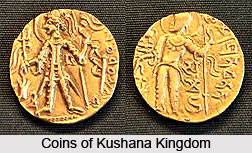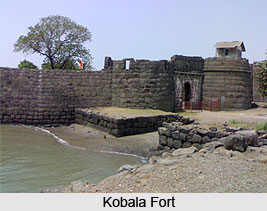 Early History of Raigad District deals with the rule of local chieftains in the early period. Earlier, this place is regarded as the city of trade and copmmerce. From the excavation, the earlier coins of Sakas, Satavahanas, Kushanas, Mauryas, Roman and Greece were found from this region.
Early History of Raigad District deals with the rule of local chieftains in the early period. Earlier, this place is regarded as the city of trade and copmmerce. From the excavation, the earlier coins of Sakas, Satavahanas, Kushanas, Mauryas, Roman and Greece were found from this region.
Kolaba Ports of Ceul, Mahad Chodeganv and Rajpuri in Janjira were probably centres of trade from the earliest historical times. The trade at that time proceessed through the openings of the Sahyadris by the Bor, Devasthali, Kumbha and Sevtya passes.
It is probable that at that time the entire Kolaba coast was ruled by a power which had its sway over both the Konkan and the Deccan and trade in the ports mentioned above shrank from foreign commerce to local traffic when Kolaba became part of Gujarat ruled by a local Chief.
The inscriptions of Kuda Caves recorded the gifts by connections of Khandapalita, the Mahabhoja, the Chief of Mandava, who probably belonged to a local dynasty with its capital at Mandad about a mile north of Kuda. Similarly, an inscription in the Pale Caves contains a reference to a Prince of a Kamboja dynasty as ruling somewhere in Kolaba at about the same time.
Rule of Kshatrapas
The Kusana emperor Kaniska I extended his power over western India at about the end of the 1st century A. D. Ksaharata Bhumaka is the earlier known Ksatrapa who was put in charge of the south-western part of the empire of the Kushanas. This Ksatrapa Bhumaka was succeeded by Nahapana who flourished about the period 60 BC. At that time, philosophy of Jainism was dominanat. At that time, Nahapana ruled Ujjain for 40 years while the inscriptions made by Ushavadata evince that Nahapana ruled for 46 years. Thus, Nahapana must have captured Ujjain in his 6th regnal year. The foreign travellers and the philosophers also mentioned the glorious rule of Kushanas in this region.
Rule of Kardamakas
Kardamakas established its authority in this region under Castana, the son of Yasamotika, after the downfall of Nahapana. The inscriptions discovered at Andhan in Kaccha evince that in the Saka year 52 (A. D. 130-31) Raja Castana was ruling jointly with his grandson Rudradaman. Castana was the Mahaksatrapa and Rudradaman, the Ksatrapa. There is evidence to show that the Sakas under Rudradaman succeeded in defeating the Satavahana king, which were conquered from Nahapana. The Junagad inscription of Rudradaman speaks of him as the lord of many countries including Akora, Avanti, Anupa, Aparanta, Saurastra and Anarta. Most of these were conquered from the time of Gautamiputra Satakarni when Rudradaman was probably a Ksatrapa under his grandfather. Later, Rudradaman came to the throne some time after 130 AD.
Rule of Satavahanas
The kings of Satavahana Dynasty came to power during the 1st century B.C, after the downfall of Rudradaman. Satavahanas had their capital at Pratisthana now identified with modern Paithan on the Godavari River Belt in Aurangabad District of Maharashtra.
Rule of Simuka
Simuka, the founder of this Simuka dynasty, distinguished himself by overthrowing Susarman, the last of the Kanva kings who ruled for 45 years, after extirpating the last Sunga king Devabhuti. On this basis, Simuka can be assigned to the 1st century BC. The Naneghat, Nasik, Sanci and Hathigumpha inscriptions referred to the rule of Simuka as well as his immediate successors, namely, Krsna and Satakarni. Both of these are known through inscriptions.
Rule of Gautamiputra Satakarni
Gautamiputra Satakarni was famous as "Saka-yavana-pallava- nisudana" and "Satavahana-kula-yasa-pratisthapanakara", came to the thorne after the death of Simuka. The Nasik inscription of the eighteenth year of his reign recorded a grant of some land that belonged to Rsabhadatta, Nahapana`s son-in-law.
Rule of Vakatakas of Vatsagulma
Vakatakas came to the power of Deccan after the fall of Satavahanas Dynasty and before the rise of Calukyas in the middle of the 6th century. Vindhyasakti, the founder of this dynasty, is mentioned in the Ajintha inscription of the time of Harisena. The epigraphic record of these Vakatakas of Vatsagulma occurs in the Basim grant of Dharma-Maharaja Vindhyasakti II, the great-grandson of Vindyasakti I, grandson of Pravarsena I and the son of Dharma-Maharaja Sarvasena. According to the Ajintha inscription, he secured a victory over the king of Kuntala about the middle of the 4th century.
Rule of Mauryas
During the 6th century, Raigad district along with the Northern Konkan coast was probably ruled by Mauryas and Nala Chiefs as Kirtivarman (550-567), the first of the Chalukyas who conquered Konkan is described as the night of death to the Nalas and Mauryas. Rithapur copper plate inscription records the grant of a village called Kadambagiri by Maharaja Bhavattavarman while he had gone on a pilgrimage to Prayag. This copper plate is assigned to the first half of the 6th century.
Rule of Pulekashin II
Pulakesin II launched the conquest by the subjugation of his neighbours. In the south Pulakesin II besieged and reduced Vanavasi, the capital of the Kadambas who had been formerly subdued by his father. Then the Gangas of South Mysore and the Alupas, who are supposed to have ruled at Humca in Shimoga district of Mysore, were compelled to submit, probably because they were allies of the Kadambas. Later it came to the hand of Chalukayas of Badami after the death of Pulekeshin II in 642 AD.



















